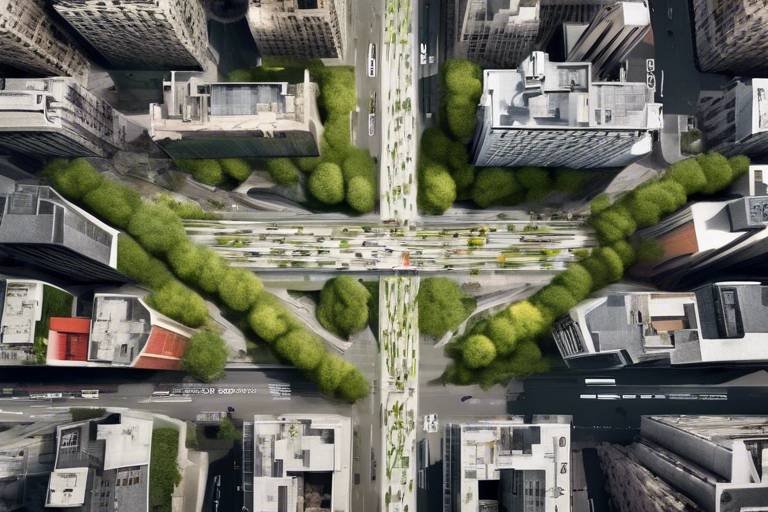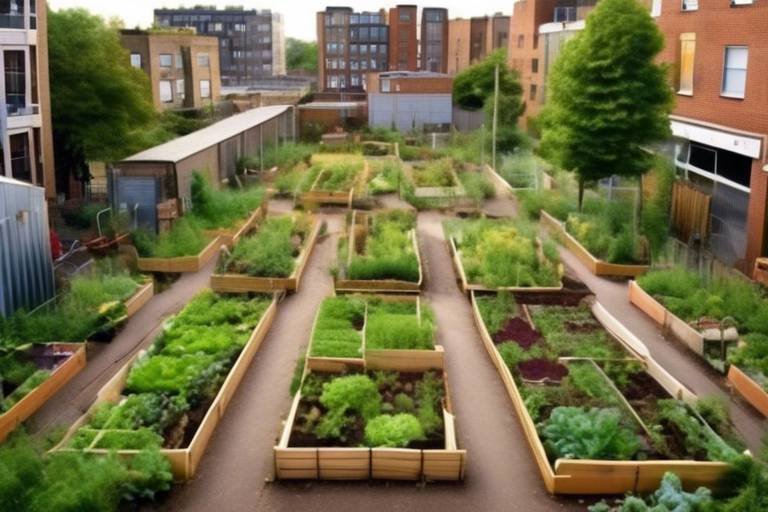How to Create Safer Walking Paths in Urban Areas for a Greener Lifestyle
In today’s fast-paced urban environments, the way we navigate our cities is evolving. With increasing concerns about health, pollution, and sustainability, creating safer walking paths has become more important than ever. Imagine stepping out of your home and feeling the fresh air on your face as you stroll down a well-designed path, flanked by greenery and bustling with life. This article explores effective strategies for designing safer walking paths in urban environments, promoting pedestrian safety, enhancing accessibility, and fostering a greener, healthier lifestyle for city dwellers.
Safe walking paths play a crucial role in urban planning, encouraging walking as a viable transportation option and reducing reliance on vehicles. When people feel safe walking, they are more likely to leave their cars at home, leading to less traffic congestion and lower carbon emissions. This shift not only benefits the environment but also enhances community health by promoting physical activity. Think about it: every step taken on a safe walking path is a step towards a healthier lifestyle and a cleaner planet. In essence, safe walking paths are the arteries of vibrant urban life, facilitating movement and connection among residents.
Implementing thoughtful design principles is essential for enhancing the safety and usability of walking paths in urban areas. Key considerations include:
- Width: A path should be wide enough to accommodate pedestrians comfortably, allowing for two-way traffic without feeling cramped.
- Surface Material: Selecting appropriate materials can prevent slips and falls. Smooth, even surfaces are ideal for all users, including those with mobility aids.
By prioritizing these factors, urban planners can create spaces that invite people to walk rather than drive. Imagine walking down a tree-lined avenue, where the path is not only safe but also aesthetically pleasing, encouraging you to take that stroll instead of hopping in your car.
Choosing the right width and surface material for walking paths ensures comfort and safety for pedestrians. A width of at least 5 feet is recommended to accommodate various users, including those walking side-by-side or with strollers. Additionally, materials like rubberized pavement or permeable pavers can minimize hazards like uneven surfaces or obstacles, making the experience pleasant for everyone.
Incorporating accessibility features, such as ramps and tactile paving, is vital for ensuring that walking paths are usable for individuals with disabilities. This inclusivity promotes a sense of belonging within the urban landscape. Think of it as creating a bridge that connects everyone, regardless of their mobility challenges. By designing paths that are accessible to all, cities can foster a community spirit that values diversity and inclusion.
Regular maintenance of walking path surfaces is essential to prevent deterioration and hazards. Cracks, potholes, and debris can turn a safe path into a dangerous one, deterring pedestrians from using it. Scheduling routine inspections and maintenance ensures a safe and pleasant experience for pedestrians year-round. A well-maintained path is like a well-tended garden; it invites people in and encourages them to explore.
Effective signage and wayfinding systems help pedestrians navigate urban environments confidently. Clear, informative signs can reduce confusion and promote the use of walking paths as a primary mode of transportation. Imagine walking through a city where every turn is marked, guiding you effortlessly to your destination. This clarity not only enhances safety but also enriches the overall walking experience.
Engaging the community in the planning process fosters a sense of ownership and encourages the development of walking paths that meet the needs and preferences of local residents. When people feel invested in their environment, they are more likely to use and care for it. It’s like planting a seed; with community involvement, it can grow into something beautiful and beneficial for everyone.
Organizing public workshops allows residents to voice their opinions and contribute ideas, ensuring that walking path designs reflect the desires of the community. These workshops can be lively forums, where ideas flow freely and creativity thrives. Residents can share their visions for the paths, whether it’s incorporating art installations or adding benches for resting. This collaborative spirit can transform a simple path into a cherished community asset.
Building partnerships with local organizations, schools, and businesses can enhance resources and support for creating and maintaining safe walking paths in urban areas. Collaborative efforts can lead to innovative solutions and funding opportunities that might not be available to individual entities. Think of it as a team sport, where everyone plays a role in making the community a better place to walk.
Safer walking paths contribute to environmental sustainability by encouraging walking over driving, reducing carbon emissions, and promoting greener urban spaces through increased vegetation and biodiversity. By prioritizing pedestrian pathways, cities can create a ripple effect that benefits the environment and its residents.
By prioritizing walking as a transportation option, cities can significantly reduce their overall carbon footprint. Every step taken on foot rather than in a car is a victory for the planet. Imagine a city where the air is cleaner, the streets are quieter, and the community is healthier. It’s not just a dream; it’s an achievable reality with the right focus on walking paths.
Integrating walking paths with green spaces creates a harmonious urban environment. Trees, flowers, and parks not only beautify the area but also improve air quality and provide residents with access to nature. Walking amidst greenery can rejuvenate the spirit, making each stroll a mini-escape from the hustle and bustle of city life.
Q: How can I get involved in planning safer walking paths in my community?
A: Attend local planning meetings, participate in public workshops, and share your ideas with city planners. Your voice matters!
Q: What materials are best for walking paths?
A: Look for materials that are durable and slip-resistant, such as rubberized pavement or permeable pavers, to ensure safety and comfort.
Q: How can I advocate for more walking paths in my area?
A: Connect with local advocacy groups, gather community support, and present your case to city officials highlighting the benefits of walking paths.
In conclusion, creating safer walking paths in urban areas is not just about infrastructure; it's about fostering a healthier, more connected community. By prioritizing thoughtful design, community involvement, and environmental sustainability, we can transform our cities into places where walking is not only safe but also enjoyable.

Importance of Safe Walking Paths
Safe walking paths are not just a luxury; they are a **necessity** in urban planning. Imagine stepping out of your home, greeted by a wide, well-maintained path that invites you to explore your neighborhood on foot. This is the kind of environment that promotes walking as a viable transportation option. When cities invest in safe walking paths, they effectively encourage residents to leave their cars behind, reducing traffic congestion and promoting a healthier lifestyle.
Moreover, these paths contribute significantly to a **healthier environment** and community. By providing safe routes for pedestrians, cities can decrease the number of accidents and injuries associated with walking, making it a more appealing mode of transport. Additionally, when people walk more, they engage with their surroundings, fostering a sense of community and connection. This social interaction can lead to stronger neighborhoods, where residents look out for one another and feel a shared responsibility for their environment.
Furthermore, the presence of safe walking paths can have a **positive impact** on mental health. Studies have shown that walking, especially in green spaces, can reduce stress and anxiety levels. When urban areas prioritize pedestrian safety, they not only enhance physical health but also contribute to the overall well-being of their residents. Walking paths become more than just routes; they transform into spaces for relaxation, reflection, and socialization.
In addition to these benefits, safe walking paths are crucial for **accessibility**. They ensure that everyone, including those with disabilities, can navigate urban areas with ease. This inclusivity is essential for creating a city that caters to all its residents, regardless of their physical abilities. By designing paths that are wide enough, well-lit, and free of obstacles, urban planners can create environments where everyone feels welcome and safe.
Ultimately, the importance of safe walking paths extends beyond individual benefits; they are a vital component of sustainable urban development. They encourage a shift away from car dependency, which is essential for reducing carbon emissions and combating climate change. Cities that prioritize walking paths are not only investing in the health of their residents but also in the health of the planet.
In summary, safe walking paths are a key element in promoting a **greener lifestyle** in urban areas. They enhance pedestrian safety, improve community interaction, and contribute to a healthier environment. As cities continue to grow, the focus on creating safe and accessible walking paths will be crucial for fostering vibrant, connected, and sustainable communities.

Design Principles for Walking Paths
When it comes to creating walking paths in urban areas, design principles are the backbone that ensures safety, accessibility, and usability. Imagine stepping onto a path that feels welcoming, where every detail has been thoughtfully considered. The right design elements can transform a simple walkway into a vibrant artery of community life. Let's delve into some essential principles that can make these paths not just functional but enjoyable for everyone.
First and foremost, the width of a walking path is crucial. A path that is too narrow can feel cramped, especially during peak hours when foot traffic is high. Ideally, walking paths should be at least five feet wide to accommodate two people walking side by side comfortably. For areas expecting higher foot traffic, consider widening the paths to eight feet or more. This extra space can make all the difference between a pleasant stroll and a frustrating squeeze.
Next, let’s talk about surface materials. The choice of material can greatly impact the safety and comfort of pedestrians. Smooth, even surfaces like concrete or asphalt are generally preferred, as they reduce the risk of tripping. However, incorporating permeable materials can also be beneficial, allowing rainwater to seep through and reduce runoff. This not only helps manage stormwater but also contributes to a greener environment. Additionally, consider the texture of the surface; a slightly textured finish can provide better traction, especially in wet conditions.
Another vital aspect is lighting. Well-lit paths increase safety and encourage evening strolls, making the area feel more secure. Installing solar-powered lights along the path can be an effective solution, providing illumination while being environmentally friendly. Furthermore, ensuring that light fixtures are positioned to eliminate dark spots can deter potential hazards and enhance the overall experience of using the path.
Accessibility features are paramount in designing walking paths that cater to everyone. Ramps should be incorporated at intersections and curbs, ensuring smooth transitions for individuals using wheelchairs or strollers. Additionally, tactile paving can guide visually impaired pedestrians along their journey, making urban spaces more inclusive. It's essential to remember that a truly accessible path is one that invites all members of the community to engage with their environment.
Lastly, regular maintenance of walking paths is non-negotiable. Cracks, debris, and overgrown vegetation can quickly turn a safe path into a hazardous one. Establishing a maintenance schedule that includes routine inspections and prompt repairs can help keep paths in top condition. Consider creating a community volunteer group to assist with maintenance efforts, fostering a sense of ownership and pride in local walking paths.
In conclusion, by focusing on these design principles—width, surface material, lighting, accessibility, and maintenance—urban planners can create walking paths that not only serve their functional purpose but also promote a sense of community and well-being. After all, a well-designed walking path is more than just a route; it’s a vital part of the urban fabric that enhances the quality of life for all city dwellers.
- What is the ideal width for a walking path? The ideal width for a walking path is at least five feet to accommodate two people walking side by side comfortably.
- What materials are best for walking paths? Smooth surfaces like concrete or asphalt are preferred, but permeable materials can also help manage stormwater.
- How important is lighting on walking paths? Lighting is crucial for safety, especially during evening hours, as it helps deter hazards and enhances the walking experience.
- What accessibility features should be included? Ramps at intersections, tactile paving for visually impaired individuals, and wide paths are essential for accessibility.
- How can communities maintain walking paths? Establishing a maintenance schedule and organizing volunteer groups can help keep walking paths in good condition.

Width and Surface Material
When it comes to designing walking paths in urban areas, the width and surface material are two of the most critical factors that can significantly influence the overall experience of pedestrians. Imagine walking along a path that feels cramped and uneven; it's not only uncomfortable but can also be hazardous. Therefore, choosing the right width is essential. A standard width of at least 5 to 6 feet is generally recommended to accommodate two-way pedestrian traffic, ensuring that people can walk side by side without feeling rushed or squeezed. This width also allows for individuals with mobility aids, like wheelchairs or strollers, to navigate comfortably.
Now, let's talk about the surface material. The choice of material impacts everything from safety to maintenance. Common materials include concrete, asphalt, and even permeable pavers. Each has its pros and cons:
| Surface Material | Advantages | Disadvantages |
|---|---|---|
| Concrete | Durable, low maintenance, smooth surface | Can crack over time, may be slippery when wet |
| Asphalt | Cost-effective, good for high traffic | Requires regular maintenance, can get hot in summer |
| Permeable Pavers | Environmentally friendly, reduces runoff | Higher initial cost, requires proper installation |
Choosing the right surface material goes beyond aesthetics; it directly affects pedestrian safety. For instance, uneven surfaces can lead to trips and falls, particularly for older adults or those with disabilities. Therefore, ensuring a smooth, even surface is not just a design choice but a necessity for safety. Additionally, incorporating features like drainage systems in the design can help mitigate water pooling, which can further enhance safety during rainy seasons.
Moreover, it's essential to consider the climate and environmental conditions of the area when selecting materials. In regions with heavy rainfall, permeable surfaces can help manage stormwater runoff, while in hotter climates, materials that remain cool underfoot can make walking more pleasant. Ultimately, the right combination of width and surface material not only enhances the walking experience but also promotes a safer and more accessible urban environment.

Accessibility Features
When it comes to designing walking paths in urban areas, are not just an afterthought; they are a necessity. Imagine a city where everyone, regardless of their physical abilities, can navigate the streets with ease and confidence. This vision can be realized by incorporating essential elements that cater to individuals with disabilities. Ramps, for instance, are crucial for those who use wheelchairs or have limited mobility. Without these, many would be confined to their homes, missing out on the vibrant life that urban areas have to offer.
Another important feature is tactile paving, which provides guidance for visually impaired pedestrians. These textured surfaces alert users to potential hazards, such as street crossings or changes in elevation. By integrating these features, cities not only comply with legal standards but also show a commitment to inclusivity and community well-being.
It's also vital to consider the width of pathways. A path that is too narrow can pose challenges for individuals using mobility aids, while a wider path accommodates a variety of users, including those walking side by side or using strollers. The surface material plays a significant role as well; it should be smooth, stable, and slip-resistant to ensure safety for all pedestrians.
Furthermore, the placement of benches and rest areas along walking paths is essential. These provide opportunities for individuals to take breaks, making it easier for those with limited stamina to enjoy the outdoors. Ultimately, the goal is to create an environment where everyone feels welcome and safe. By prioritizing accessibility features, cities can transform walking paths into inclusive spaces that foster a sense of belonging for all residents.
- What are the key features of accessible walking paths? Accessible walking paths should include ramps, tactile paving, wide surfaces, and rest areas to accommodate all users.
- Why is accessibility important in urban planning? Accessibility ensures that all individuals, regardless of their physical abilities, can navigate and enjoy urban spaces, promoting inclusivity.
- How can communities get involved in improving accessibility? Communities can engage in public workshops to voice their needs and collaborate with local organizations to advocate for better accessibility measures.

Surface Maintenance
Maintaining the surfaces of walking paths is not just a matter of aesthetics; it is a crucial aspect of ensuring pedestrian safety and comfort. Over time, surfaces can become worn, cracked, or uneven due to weather conditions, heavy usage, or natural wear and tear. These issues can pose significant hazards to pedestrians, especially for those with mobility challenges. Regular surface maintenance is essential to keep these paths safe and enjoyable for everyone.
Consider this: a well-maintained walking path is like a well-tended garden. Just as weeds and overgrowth can choke the life out of plants, debris and damage can deter people from using walking paths. By implementing a systematic maintenance schedule, urban planners and local governments can ensure that walking paths remain inviting and safe. This includes routine inspections to identify and address potential hazards, as well as immediate repairs to any surface damage.
Here are some key aspects of effective surface maintenance:
- Regular Inspections: Conducting frequent inspections helps identify issues early. Look for cracks, holes, or any surface irregularities that could lead to trips or falls.
- Prompt Repairs: When damage is found, timely repairs are essential. Delaying repairs can exacerbate the problem, leading to more extensive damage and increased costs.
- Cleaning: Keeping the path clean from debris, leaves, and litter not only enhances its appearance but also prevents slippery conditions that can lead to accidents.
- Surface Treatments: Depending on the material, applying sealants or anti-slip treatments can extend the life of the path and improve safety.
Furthermore, creating a community maintenance program can foster a sense of ownership among residents. When local volunteers participate in the upkeep of walking paths, it not only enhances the paths themselves but also strengthens community bonds. Imagine neighbors coming together, tools in hand, to spruce up their local walking route, turning maintenance into a social event!
In conclusion, surface maintenance is a vital component in the design and sustainability of urban walking paths. By prioritizing regular inspections, prompt repairs, and community involvement, cities can create safer, more enjoyable walking experiences that encourage a healthier lifestyle for all residents.
- Why is surface maintenance important for walking paths? Regular maintenance ensures safety, prevents accidents, and enhances the overall experience for pedestrians.
- How often should walking paths be inspected? It is advisable to conduct inspections at least quarterly, or more frequently in areas with heavy foot traffic.
- What should I do if I notice a hazard on a walking path? Report it to your local government or community organization so they can address the issue promptly.
- Can community members help with maintenance? Absolutely! Organizing community cleanup days can be a great way to involve residents in maintaining their local paths.

Signage and Wayfinding
When it comes to urban walking paths, are more than just helpful tools—they're essential elements that can transform the pedestrian experience. Imagine strolling through a bustling city, only to find yourself lost amidst towering buildings and busy streets. Frustrating, right? This is where effective signage comes into play. Well-placed, clear signs can guide pedestrians effortlessly, making them feel more confident and comfortable as they navigate their surroundings.
Moreover, the design of these signs is crucial. They should be visible from a distance, easy to read, and strategically located at decision points, such as intersections and path junctions. Think of them as the friendly locals who point you in the right direction. Incorporating symbols and icons can also help convey information quickly, especially for those who might not speak the local language. For instance, a simple graphic of a pedestrian can indicate a walking path, while arrows can guide the way to nearby parks or amenities.
In addition to traditional signage, wayfinding systems can enhance the pedestrian experience significantly. Digital maps, interactive kiosks, and even mobile apps can provide real-time information about walking routes, estimated travel times, and nearby attractions. These tools are like having a personal tour guide in your pocket! They not only help pedestrians find their way but also encourage them to explore new areas, fostering a sense of adventure and discovery.
Furthermore, incorporating community input into the signage design process can lead to even better outcomes. Engaging local residents in discussions about what they would like to see can result in signage that resonates with the community's identity and culture. For example, using local art or language in the signage can create a unique sense of place, making the walking paths feel more inviting and personalized.
To sum it up, effective signage and wayfinding are critical components in creating safer, more enjoyable walking paths in urban areas. By investing in these elements, cities can enhance pedestrian safety, promote walking as a primary mode of transportation, and ultimately contribute to a more vibrant and connected community.
- What is the purpose of signage on walking paths?
Signage serves to guide pedestrians, provide information about nearby amenities, and enhance safety by indicating potential hazards or directions. - How can wayfinding systems improve pedestrian experiences?
Wayfinding systems, such as digital maps and kiosks, help pedestrians navigate urban environments more easily, reducing confusion and encouraging exploration. - Why is community involvement important in signage design?
Engaging the community ensures that the signage reflects local culture and preferences, making walking paths feel more inviting and relevant to residents.

Community Involvement in Path Planning
When it comes to creating safer walking paths in urban areas, community involvement is not just a nice-to-have; it's a fundamental element that can transform the planning process. Imagine a neighborhood where the residents actively shape their environment, voicing their needs and preferences. This is the essence of community engagement. It fosters a sense of ownership among locals, making them more likely to use and maintain these paths, which ultimately enhances their safety and usability.
One effective way to engage the community is through public workshops. These gatherings allow residents to come together, share their ideas, and express their concerns regarding walking paths. Think of it as a town hall meeting but with a focus on foot traffic! During these workshops, planners can present different design options and gather feedback directly from those who will be using the paths. This two-way communication ensures that the walking paths meet the actual needs of the community rather than the assumptions of distant planners.
Another avenue for involvement is through collaborative partnerships. By teaming up with local organizations, schools, and businesses, urban planners can pool resources and expertise to create walking paths that are not only safe but also vibrant and engaging. For instance, a local school might partner with the city to design a walking route that encourages students to walk to school safely. Such partnerships can also lead to the incorporation of community art, signage, and greenery along the paths, making them more inviting.
Furthermore, utilizing social media platforms can be a game-changer in gathering community input. A simple online survey can reach hundreds of residents in a matter of days, providing valuable insights into their preferences and concerns. By leveraging technology, planners can ensure that even those who may not be able to attend workshops can still have their voices heard.
Ultimately, when communities are involved in the planning of walking paths, the results are often more successful and sustainable. Residents are more likely to embrace paths that reflect their input, whether that means adding benches for resting, improving lighting for safety, or incorporating green spaces for relaxation. This collaborative approach not only enhances the walking experience but also strengthens community ties, creating a network of engaged citizens who care about their urban environment.
- Why is community involvement important in path planning? Community involvement ensures that the needs and preferences of local residents are met, leading to more effective and sustainable walking paths.
- How can residents participate in the planning process? Residents can participate through public workshops, feedback sessions, and online surveys to share their ideas and concerns.
- What role do partnerships play in path planning? Partnerships with local organizations and businesses can enhance resources and support for creating and maintaining walking paths.
- How does community engagement improve safety? When residents are involved, they are more likely to use and care for the paths, which can lead to increased safety through natural surveillance and maintenance.

Public Workshops and Feedback
When it comes to creating safer walking paths in urban areas, engaging the community is not just a good idea—it's essential. Public workshops serve as a platform for residents to share their thoughts, experiences, and suggestions regarding walking paths in their neighborhoods. Imagine a vibrant gathering where people from all walks of life come together, fueled by a shared passion for improving their community. This is where the magic happens! By providing a space for open dialogue, we can tap into the collective wisdom of the community, ensuring that the designs reflect their true needs and desires.
During these workshops, participants can voice their opinions on various aspects of walking path design. For instance, they might discuss the importance of safety, accessibility features, and how the paths could better connect to parks or public transport. It's also an opportunity to highlight any existing issues, such as poorly lit areas or uneven surfaces that have made walking less safe or enjoyable. By gathering this feedback, urban planners can make informed decisions that prioritize the community's needs.
In addition to verbal feedback, workshops can utilize tools such as interactive maps and surveys to gather more structured input. For instance, attendees could mark their favorite walking routes and identify areas that need improvement. This visual feedback can be incredibly powerful, allowing planners to see the community's preferences in real-time. Plus, it fosters a sense of ownership among residents, making them feel like they are part of the solution.
Moreover, the feedback gathered doesn't just stop at the workshop. It's crucial to keep the conversation going. Urban planners should provide updates on how community input is being integrated into the walking path designs. This transparency builds trust and encourages ongoing participation. When residents see that their voices matter, they are more likely to engage in future discussions, creating a continuous cycle of improvement and collaboration.
Ultimately, public workshops are about more than just gathering feedback; they are about building a community. They create a space where residents can connect, share ideas, and collaborate on a common goal—creating safer, more accessible walking paths that enhance their urban environment. So, the next time you hear about a workshop in your area, consider attending. Your voice could be the key to shaping a greener, safer future for everyone!
- What are public workshops? Public workshops are community gatherings that allow residents to share their feedback and ideas about local projects, such as walking path designs.
- How can I participate in a workshop? Participation details are usually provided through local government websites or community boards. Keep an eye out for announcements!
- Why is community feedback important? Community feedback ensures that the needs and desires of local residents are reflected in urban planning, leading to more effective and appreciated designs.
- What happens to my feedback after the workshop? Feedback is typically reviewed by urban planners, who will use it to inform their designs and may provide updates to the community on how suggestions are being implemented.

Collaborative Partnerships
When it comes to creating safer walking paths in urban areas, the power of cannot be overstated. By joining forces with local organizations, schools, and businesses, cities can harness a wealth of resources and expertise that can significantly enhance the planning, development, and maintenance of walking paths. Imagine a scenario where the community, city planners, and local businesses come together, each contributing their unique strengths to a common goal. This synergy not only leads to better designs but also fosters a sense of ownership and pride among residents.
For instance, local businesses can play a vital role by sponsoring walking path improvements or events that promote walking as a primary mode of transport. Schools can integrate walking paths into their curricula, teaching students about the benefits of walking while encouraging them to use these paths safely. Moreover, community organizations can mobilize volunteers for maintenance and beautification projects, ensuring that walking paths remain inviting and well-kept.
To illustrate the potential impact of these partnerships, consider the following table that outlines various stakeholders and their contributions:
| Stakeholder | Potential Contributions |
|---|---|
| Local Businesses | Sponsorship of events, funding for improvements, promotions for walking |
| Schools | Education on pedestrian safety, student-led walking groups, advocacy for safe routes |
| Community Organizations | Volunteer maintenance, community events, fundraising for path enhancements |
| City Planners | Design and implementation of paths, policy support, safety assessments |
In addition to these contributions, collaborative partnerships can also facilitate community engagement. When residents see their local businesses and organizations actively participating in the enhancement of walking paths, they are more likely to feel empowered to use them. This not only increases foot traffic but also strengthens community ties, as people begin to interact more with their environment and each other. So, let’s not underestimate the value of collaboration; it’s the key to creating vibrant, safe, and accessible walking paths that cater to the needs of everyone in the community.
- What are the benefits of collaborative partnerships in urban planning?
Collaborative partnerships bring together diverse perspectives and resources, leading to more effective solutions and greater community buy-in. They enhance the planning process by ensuring that the needs and desires of residents are considered.
- How can local businesses contribute to safer walking paths?
Local businesses can contribute by sponsoring improvements, promoting walking through marketing campaigns, and participating in community events that encourage pedestrian use.
- What role do schools play in promoting walking paths?
Schools can educate students about the importance of walking, organize walking groups, and advocate for safe routes to school, thus fostering a culture of walking from a young age.

Environmental Benefits of Walking Paths
When we think about urban environments, it's easy to get lost in the hustle and bustle of city life. However, one of the most significant yet often overlooked aspects of city planning is the creation of walking paths. These paths are not just for pedestrians; they serve as vital arteries in the urban ecosystem, promoting a myriad of environmental benefits that can lead to a greener, healthier lifestyle for everyone. So, why should we care about walking paths? Well, let’s dive into the details!
First and foremost, safer walking paths encourage more people to ditch their cars and opt for walking instead. This shift not only reduces traffic congestion but also leads to a significant decrease in carbon emissions. Imagine a city where the air is cleaner, the streets are less congested, and the sounds of honking horns are replaced by the gentle rustle of leaves. By prioritizing pedestrian-friendly infrastructure, urban planners can help cities take a giant leap toward sustainability.
Moreover, walking paths can be beautifully integrated with green spaces, creating a harmonious urban environment. This integration enhances biodiversity, allowing various plant and animal species to thrive right in the heart of the city. Picture walking down a path lined with trees, flowers, and shrubs that not only beautify the area but also contribute to improved air quality. Studies show that urban greenery can help absorb pollutants and provide oxygen, making our cities healthier places to live.
In addition, walking paths can foster community interaction and engagement, which is essential for building a sense of belonging among residents. When people feel connected to their environment, they are more likely to care for it. This can lead to community-led initiatives aimed at maintaining these paths, planting trees, or even organizing clean-up days. It’s a cycle of positivity that promotes both environmental responsibility and social cohesion.
To further illustrate the impact of walking paths on the environment, let’s consider the following table:
| Benefits of Walking Paths | Impact on Environment |
|---|---|
| Reduction in Carbon Emissions | Encourages walking over driving, resulting in lower emissions. |
| Improved Air Quality | Greenery along paths absorbs pollutants and produces oxygen. |
| Enhanced Biodiversity | Supports various species and creates habitats within urban areas. |
| Community Engagement | Fosters a sense of ownership and responsibility towards the environment. |
In conclusion, the environmental benefits of walking paths extend far beyond mere aesthetics. They are essential components of a sustainable urban lifestyle, promoting not only a healthier planet but also a vibrant community. By investing in walking paths, cities can create spaces that encourage walking, enhance biodiversity, and foster a sense of belonging among residents. So, the next time you lace up your shoes for a stroll, remember that each step contributes to a greener future!
- How do walking paths reduce carbon emissions? Walking paths encourage people to walk instead of driving, which decreases the number of vehicles on the road, leading to lower carbon emissions.
- What role do green spaces play in urban walking paths? Green spaces improve air quality, provide habitats for wildlife, and enhance the aesthetic appeal of walking paths, making them more inviting.
- How can communities get involved in the planning of walking paths? Communities can participate in public workshops, provide feedback, and collaborate with local organizations to ensure walking paths meet their needs.
- Are walking paths safe for everyone? Yes, when designed with proper width, surface materials, and accessibility features, walking paths can be safe for all pedestrians, including those with disabilities.

Reducing Carbon Footprint
In today's rapidly urbanizing world, the need to reduce our carbon footprint has never been more critical. One of the most effective ways to achieve this is by encouraging walking as a primary mode of transportation. When we think about it, walking is not just a means of getting from point A to point B; it’s a lifestyle choice that can significantly impact our environment. By prioritizing pedestrian-friendly infrastructure, cities can inspire residents to leave their cars behind, even if just for short trips.
Consider this: every time someone chooses to walk instead of drive, they are contributing to a decrease in carbon emissions. According to studies, a single car produces approximately 4.6 metric tons of carbon dioxide per year. Imagine the positive environmental impact if more people opted for walking! Not only does this help in reducing air pollution, but it also promotes healthier lifestyles, creating a win-win situation for both the planet and its inhabitants.
Moreover, the integration of walking paths into urban planning can lead to a multiplier effect. As more people walk, the demand for public transportation may also increase, leading to a more sustainable transit system. This shift not only reduces the reliance on personal vehicles but also enhances community interaction, as people are more likely to engage with their surroundings when they are on foot. The ripple effects can be profound:
| Impact of Walking on Carbon Emissions | Reduction in CO2 Emissions |
|---|---|
| 1 Person Walking 1 Mile Instead of Driving | ~1 pound of CO2 saved |
| 100 People Walking 1 Mile Instead of Driving | ~100 pounds of CO2 saved |
| 1 Week of Walking Instead of Driving (100 People) | ~700 pounds of CO2 saved |
Additionally, walking paths can be designed to connect with green spaces, further enhancing their environmental benefits. These paths not only encourage physical activity but also promote biodiversity by providing habitats for various species. The presence of trees and plants along walking routes can help absorb carbon dioxide and improve air quality, creating a more pleasant atmosphere for pedestrians.
In essence, by investing in safe and accessible walking paths, cities are not just improving their infrastructure; they are taking a bold step towards a more sustainable future. It's all about making choices that benefit both our health and our planet. So, the next time you consider hopping in your car for a short trip, think about the impact of walking instead. Every step counts!
- How does walking contribute to reducing carbon emissions? Walking eliminates the need for a vehicle, which in turn reduces the amount of carbon dioxide released into the atmosphere.
- What are some benefits of creating walking paths in urban areas? Walking paths promote physical activity, improve mental health, enhance community interaction, and contribute to environmental sustainability.
- Can walking paths help with local wildlife? Yes! Integrating green spaces with walking paths provides habitats for wildlife and promotes biodiversity.

Enhancing Urban Green Spaces
Integrating walking paths with green spaces is not just about aesthetics; it’s a crucial step towards creating a more sustainable and livable urban environment. Imagine strolling down a path surrounded by lush trees, vibrant flowers, and chirping birds, instead of concrete walls and traffic noise. This transformation can significantly enhance the quality of life for city dwellers. Urban green spaces provide a natural escape from the hustle and bustle, offering residents a place to relax, exercise, and connect with nature.
When we talk about enhancing urban green spaces, we’re really focusing on a few key elements that can make a big difference:
- Increased Vegetation: Planting more trees and shrubs along walking paths not only beautifies the area but also improves air quality. Trees act as natural air filters, absorbing pollutants and releasing oxygen. They provide shade, making the paths more comfortable during hot summer days.
- Community Gardens: Incorporating community gardens along walking paths encourages local residents to engage with their environment. These spaces can serve as a source of fresh produce, foster community spirit, and educate people about sustainable practices.
- Wildlife Habitats: Designing green spaces to support local wildlife can enhance biodiversity. This might include creating habitats for birds, butterflies, and other pollinators, which are essential for a balanced ecosystem.
Furthermore, the psychological benefits of green spaces cannot be overstated. Studies have shown that spending time in nature can reduce stress, improve mood, and enhance overall mental well-being. For city dwellers, having accessible green paths means they can enjoy these benefits without having to travel far from home. It’s about making nature a part of everyday life.
To effectively enhance urban green spaces, cities can implement several strategies:
| Strategy | Description |
|---|---|
| Native Plant Landscaping | Using native plants that thrive in the local environment reduces water usage and maintenance costs while supporting local wildlife. |
| Permeable Surfaces | Incorporating permeable materials for walking paths allows rainwater to infiltrate the ground, reducing runoff and promoting groundwater recharge. |
| Community Involvement | Engaging local residents in the planning and maintenance of green spaces fosters a sense of ownership and responsibility, ensuring these areas are well cared for. |
Ultimately, enhancing urban green spaces is about creating a balanced ecosystem that benefits both people and nature. By prioritizing these green areas, cities can promote a healthier lifestyle, encourage walking as a primary mode of transportation, and create a more inviting atmosphere for residents and visitors alike. It's a win-win situation that leads to a greener, more sustainable future.
Q1: How do walking paths contribute to urban green spaces?
A1: Walking paths can connect various green spaces, encouraging people to use these areas and appreciate nature while promoting a healthier lifestyle.
Q2: What are the environmental benefits of increasing green spaces in urban areas?
A2: Increasing green spaces helps reduce air pollution, lowers urban temperatures, supports biodiversity, and improves overall mental health for city residents.
Q3: How can communities get involved in enhancing their local green spaces?
A3: Communities can organize clean-up events, plant trees, or establish community gardens, fostering a sense of ownership and pride in their local environment.
Frequently Asked Questions
-
Why are safe walking paths important in urban areas?
Safe walking paths are vital because they encourage people to walk instead of relying on vehicles. This not only promotes a healthier lifestyle but also contributes to reducing traffic congestion and lowering carbon emissions. Think of it as a win-win for both your health and the environment!
-
What design features should be considered for walking paths?
When designing walking paths, several features need to be considered, including the width of the path, surface materials, and adequate lighting. These elements ensure that paths are comfortable and safe for all users, minimizing hazards like uneven surfaces or obstacles. It's all about creating a welcoming space for everyone!
-
How can communities get involved in the planning of walking paths?
Communities can play a significant role by participating in public workshops and providing feedback on proposed designs. This collaboration helps ensure that the walking paths meet the needs and desires of local residents, fostering a sense of ownership and pride in their urban environment.
-
What accessibility features should be included in walking paths?
Accessibility features such as ramps, tactile paving, and clear signage are essential for ensuring that walking paths are usable by everyone, including individuals with disabilities. By incorporating these elements, cities can promote inclusivity and make sure that no one is left out.
-
How do walking paths benefit the environment?
Walking paths benefit the environment by encouraging walking instead of driving, which helps reduce carbon emissions. Additionally, they can be integrated with green spaces, enhancing biodiversity and improving air quality. It's like creating a natural oasis in the heart of the city!
-
What maintenance is required for walking paths?
Regular maintenance is crucial to keep walking paths safe and enjoyable. This includes repairing any damage, clearing debris, and ensuring that signage is visible. By staying on top of maintenance, cities can provide a pleasant experience for pedestrians year-round.



















